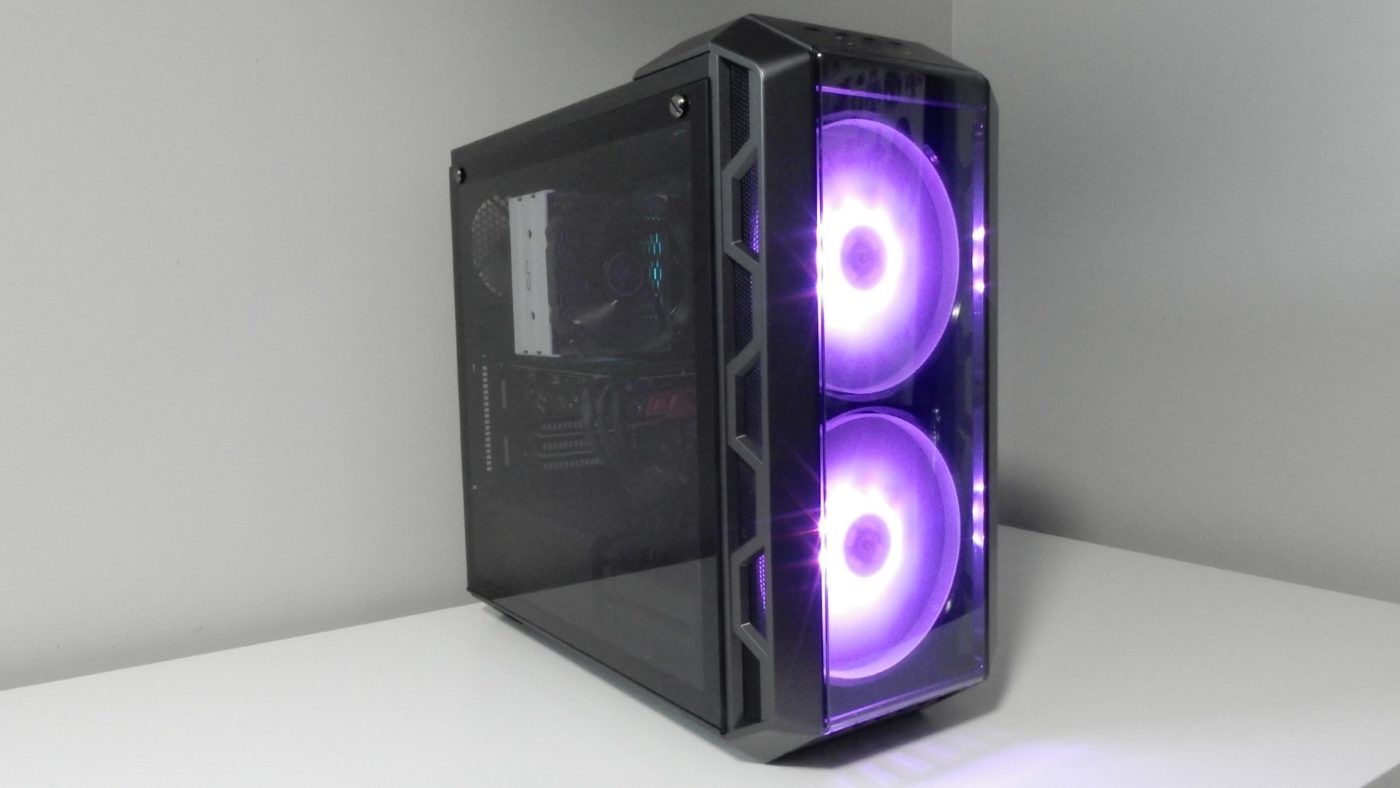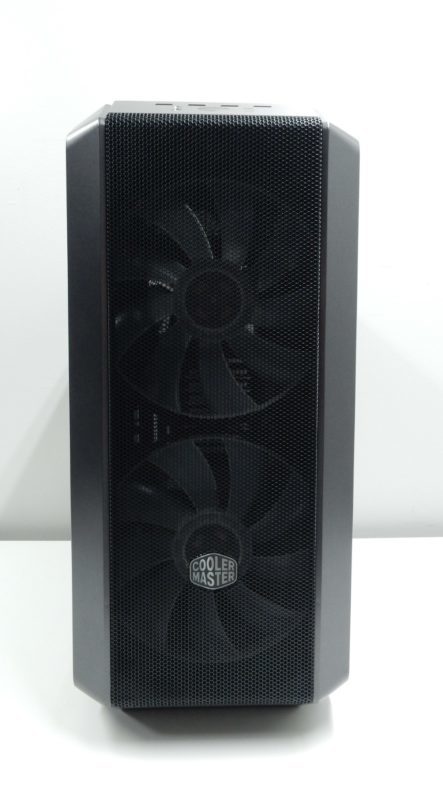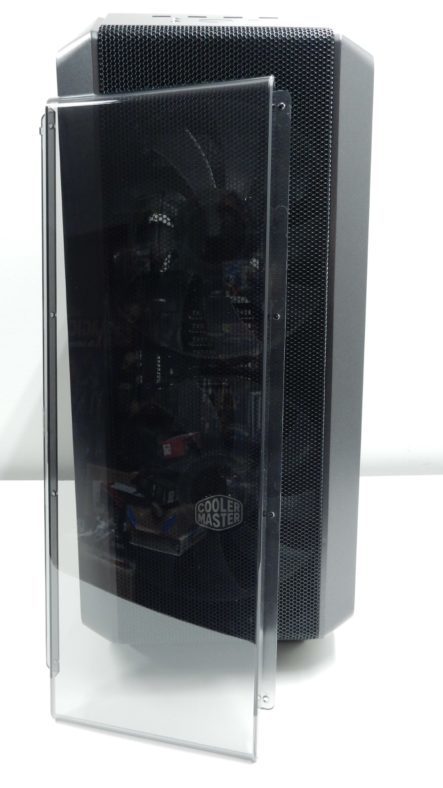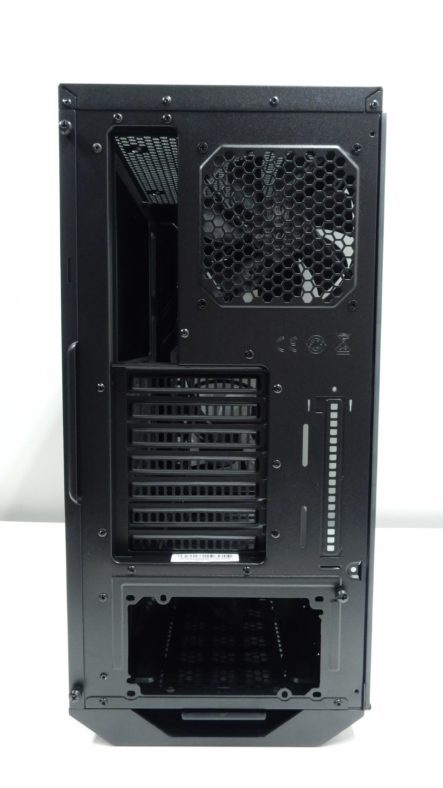Cooler Master MasterCase H500 Overview
Now that the H500 has been removed from its protective packaging, we can get a better look at this mid-sized case. Offered in a single color, Iron Grey, the H500 could easily be mistaken for a standard black case, but in the right light, you can really see the grey come out. We like this color choice, as it sets the case apart from your standard black or white case without being another extreme color that could make a cohesive looking build nearly impossible. Case materials are your standard steel and plastic, with a tempered glass side panel for a complete view into the side of the case. Being a mid-tower case, the H500 supports Mini-ITX, Micro-ATX, and ATX motherboards, along with videocards up to 410mm in length.
Starting out on the left side of the case, we are greeted with a nearly full-panel tempered glass side. Aside from a bit of metal case body above the glass panel, we are treated to a tinted, yet transparent, glossy surface. The tempered glass panel is held in place by two over-sized captive screws on the top left and right corners, while the bottom of the panel uses a small metal frame that “slots” into the frame of the case. We were pretty happy with how the panel installed, as you can simply place the bottom of the panel in its place and not have to worry about holding the panel in place with a fear of dropping it. The outer borders of the panel feature the standard black trim that hides the inner frame of the case.
The right side of the case is home to a plain side panel that is held in place by two thumbscrews. The side panel does a have a small “handle” at the back to make removal a bit easier, but this is nothing special, and is pretty much standard with any case of quality.
Up front we are greeted with a nearly full mesh design, though this look can be changed with a little work. The 228mm width of the H500 allows for the use of 200mm fans up front and at the top, and we can see the two included 200mm RGB fans with ease at the front of the case through the mesh facade that runs from top to bottom. This mesh features a small hexagon pattern with a finer mesh filter just behind it for some dust capturing capabilities. While quite transparent, this dual mesh design still provides a bit of an obstructed look into the front of the case. Flanking the mesh center portion of the front panel are gray pillars that make their way along the entire height of the case. The front panel of the H500 sticks out about 2.5 inches from the frame of the case, which allows for a good amount of additional airflow to come in along the sides and bottom of the front panel. The same hexagon and fine mesh material is found here, and is critical for when the transparent front panel is installed.
Speaking of the transparent front panel, the H500’s front panel can be modified to provide a clear look into the front of the case. With the front panel removed from the case, eight screws can then be removed to allow you to swap out the mesh panel for a slightly tinted plastic front panel. While this look will decrease the amount of intake airflow for the front-mounted fans, the mesh found on the sides and bottom of the front panel will allow for a bit of flow. We would have liked to see a tool-less design for swapping out this front panel material, but once you decide on a look you like, you probably won’t be changing it up too often.
At the top of the front panel, we find and angled panel that serves as home to the H500’s various ports and buttons. It is here we find two USB 3.0 Type-A ports, two USB 2.0 Type-A ports, headphone and mic jacks, an illuminated Cooler Master “hexagon” power button, small reset button, and drive status LED indicator. We really wish we could have seen a USB Type-C port here, as it is just becoming more and more prolific, but that just wasn’t in the books for us.
Moving to the back of the case we find a pretty standard mid-tower layout. Up top is your basic I/O shield opening, and a 120mm fan grille to the side, which is populated with an included fan. Moving down we have seven expansion slots, each with a vented slot cover for some passive airflow. A single vertical cutout is just to the right of these expansion slots, though there is no included use for the slot. At the bottom of the rear we have a power supply opening that supports both fan-up and fan-down orientations. There is also a single thumbscrew near the power supply opening, but we will cover it’s purpose a bit later.
The top of the H500 is home to one of the case’s most unique features, though we are a bit apprehensive of actually using it. You see, the front panel design of the case continues its way up to the top of the case and makes itself into an integrated case handle. While Cooler Master claims the handle supports up to 20kg, the case itself weighs in at 9.22kg, leaving less than 11kg for the rest of your components. And while we know the handle is great for quick moves around your desk or room since we used it for that, we wouldn’t trust carrying the case with just the handle from your car into a LAN party or for any extended time period. With that out of the way, we also find a large, magnetically-attached, mesh filter on the top of the case, which can be easily removed to find multiple fan or radiator mounting options below. It is here that we find room for a third 200mm fan, or multiple 120mm and 140mm fan or radiator mounting options.











